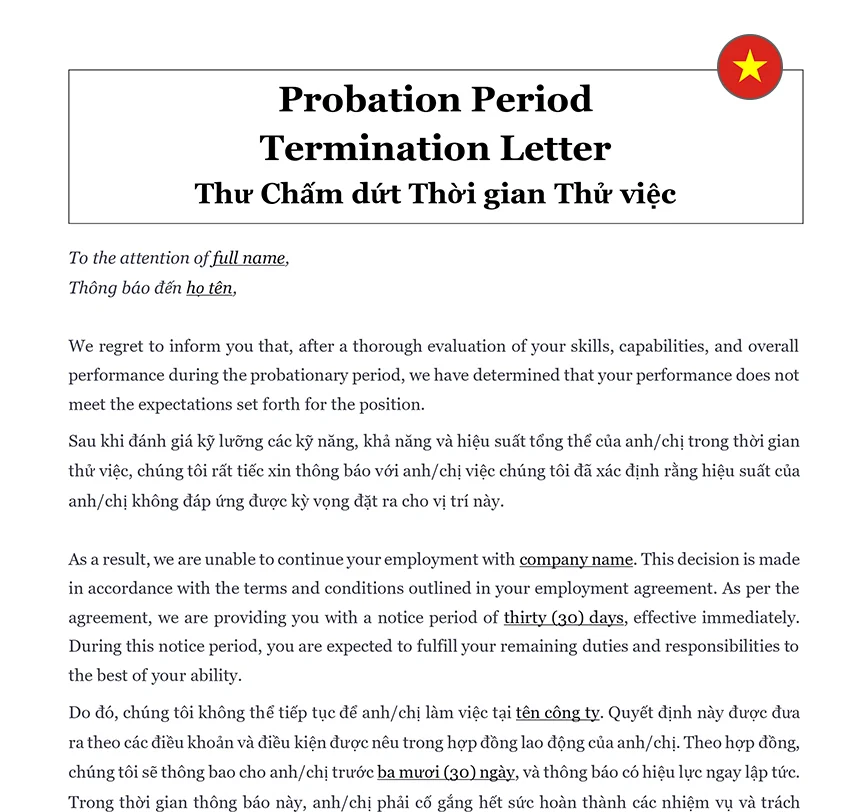Ready to use legal template
Drafted by experienced lawyers
Vietnamese-English translation
Ready to use legal template
Drafted by lawyers
Vietnamese-English translation
Learn more about Employee Probation Period Termination in Vietnamese
Employee probation period termination refers to the cessation of employment during the initial trial period, typically for performance-related reasons or mutual agreement between the employer and the employee. At Themis Partner law firm in Vietnam, we understand the importance of ensuring such terminations are conducted in accordance with local regulations and contractual obligations. Our legal team has meticulously crafted an Employee Probation Period Termination document, tailored to comply with Vietnamese labor laws. Delivered in a user-friendly Word format, our templates help employers to navigate this process efficiently while safeguarding legal compliance.
Table of contents
-
What is an Employee Probation Period Termination?
-
What is included in an Employee Probation Period Termination?
-
Why use an Employee Probation Period Termination in Vietnam?
-
How to communicate probation period termination to the employee?
-
How long is the probation period for employees in Vietnam?
-
What steps to take before deciding to terminate an employee?
-
Can an employee challenge their termination in Vietnam?
-
Are there any alternative options to termination during probation?
-
Are there any restrictions on terminating employees during probation?
What is an Employee Probation Period Termination?
Employee Probation Period Termination is a pivotal stage in the employment journey, occurring within the probationary period designated at the outset of employment. This probationary phase allows both the employer and the employee to assess the compatibility of the role and the individual’s performance and suitability for the position. Termination during this period signifies the premature conclusion of the employment relationship, often due to factors such as unsatisfactory performance, behavioral issues, or a lack of alignment with organizational values or job requirements. Employers typically use this probationary period as an opportunity to evaluate the employee’s performance and potential contribution to the organization, making informed decisions regarding their continued employment beyond the probationary period.
For employees, probation period termination can evoke feelings of uncertainty and disappointment, as it represents an unexpected end to their employment opportunity. It may also prompt individuals to reflect on their performance and areas for improvement. From the employer’s perspective, probation period termination is a strategic decision aimed at ensuring that the organization maintains a high-performing workforce aligned with its goals and values. By carefully managing probationary terminations, employers can uphold standards of performance and conduct while fostering a productive work environment conducive to long-term success.
What is included in an Employee Probation Period Termination?
An Employee Probation Period Termination typically includes several key components to ensure clarity and legal compliance:
Termination Notice: The notice period required for termination, as stipulated in the employment contract or by labor laws, should be clearly communicated to the employee.
Reason for Termination: A concise explanation of the reasons for terminating the employee during the probationary period, such as poor performance, misconduct, or organizational restructuring, should be provided.
Effective Date of Termination: The date on which the termination becomes effective should be specified, marking the end of the probationary period and the employment relationship.
Final Wages and Benefits: Details regarding the payment of final wages, accrued benefits, and any outstanding entitlements owed to the employee should be outlined.
Return of Company Property: Instructions for the return of company-owned assets, such as equipment, access cards, or uniforms, should be included to facilitate the transition out of the organization.
Confidentiality and Non-Disclosure Obligations: Reminders of the employee’s ongoing obligations to maintain confidentiality and refrain from disclosing proprietary information following termination should be provided.
Release of Claims: A provision offering the employee the opportunity to release the employer from any potential claims or disputes arising from the termination should be included, along with guidance on seeking legal advice if necessary.
Acknowledgment of Receipt: A section for the employee to acknowledge receipt of the termination letter and its contents, confirming their understanding of the termination process.
Why use an Employee Probation Period Termination in Vietnam?
Using an Employee Probation Period Termination in Vietnam serves several purposes:
| ➤ Assessment of Fit: The probationary period allows employers to assess whether the employee is a suitable fit for the role and the organization. If the employee's performance or behavior during this period indicates a mismatch with the job requirements or company culture, termination provides a mechanism to address the issue early on. |
| ➤ Legal Compliance: Terminating an employee during the probationary period may be simpler and less legally complicated than terminating a regular employee. By adhering to the termination procedures outlined in the labor laws of Vietnam and the terms specified in the employment contract, employers can mitigate legal risks associated with termination. |
| ➤ Performance Management: Probation period termination can serve as a tool for managing performance issues within the organization. It allows employers to address performance concerns promptly, providing feedback to the employee and taking corrective action if necessary. |
| ➤ Efficiency: If an employee is not meeting expectations or is not a good fit for the role, terminating their employment during the probationary period can save time and resources for both the employer and the employee. It prevents prolonged underperformance or dissatisfaction, allowing the organization to focus on finding a more suitable candidate. |
| ➤ Maintaining Standards: Enforcing probationary terminations when necessary reinforces the organization's standards of performance, conduct, and professionalism. It sends a message that the company values excellence and accountability from its employees, contributing to a positive work culture. |




